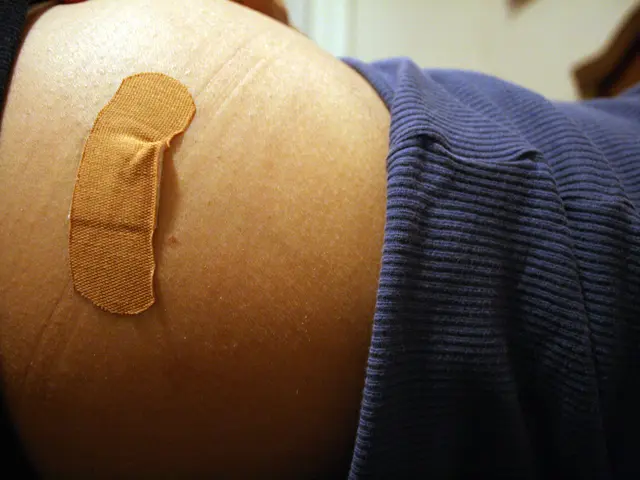Artificial Intelligence: A Game Changer for Early Breast Cancer Detection in the U.S.
Artificial Intelligence may aid in enhancing the detection of breast cancers during periodic screenings.
Mammographic screenings are crucial for early breast cancer detection, yet some cancers slip through the cracks, known as interval breast cancers (IBCs). These are tumors that appear between routine screenings or go unnoticed during the initial check-up due to fast growth or human oversight. Enter artificial intelligence (AI) - a promising tool designed to improve detection rates by incorporating precision and accuracy.
Recent research sheds light on the impact of AI in U.S. practices, a topic that often takes a backseat to European studies. The new study spearheaded by researchers at the University of California, Los Angeles (UCLA)'s Jonsson Comprehensive Cancer Center set out to explore the potential of AI in IBC detection within the American healthcare landscape.
At the heart of the study, published in the Journal of the National Cancer Institute, was the compelling finding that AI could help reduce IBC numbers by an estimated 30% by picking up on subtle signs that might otherwise be missed by human radiologists. In fact, the AI tool flagged 76% of mammograms that, at first, were considered normal but later linked to IBCs, and it detected 90% of missed reading error cases, where the cancer was visible yet missed or misinterpreted by the radiologist.
However, the researchers also uncovered what Dr. Hannah Milch, senior author of the study, called "AI inaccuracy and issues" that need to be addressed in real-world settings. For instance, despite being invisible on mammography, the tool still flagged 69% of the screening mammograms that had occult cancers, yet only marked the actual cancer 22% of the time. This demonstrates the need for continued development, validation, and seamless integration of AI systems in clinical practice.
Adopting AI in breast cancer screening could offer several noteworthy benefits:
- Improved Detection Accuracy: By identifying subtle signs that may be overlooked by the human eye, AI could augment the precision of mammographic readings.
- Efficiency: AI can process a multitude of images quickly, potentially speeding up the screening process and reducing radiologists' workload.
- Personalized Screening: Integrating AI with risk models could facilitate tailored screenings based on individual breast density and risk factors.
- Increased Patient Support: Patients may respond favorably to AI integration, signifying potential benefits in engagement and trust, as surveys suggest[3].
Nonetheless, challenges remain in implementing AI in clinical settings:
- Data Quality and Availability: AI models require quality and diverse datasets to learn effectively, and gaps in dataset diversity can introduce biases.
- Regulatory Approval and Integration: The process of receiving regulatory approval and integrating AI with existing healthcare systems can be complex and time-consuming.
- Public Acceptance and Trust: While there is cautious support from patients, widespread acceptance hinges on transparency and understanding of AI's role in the screening process.
- Technological Limitations: AI is not foolproof and may miss certain types of cancers or misinterpret images, leading to potential false reassurances or unwarranted concerns.
Furthermore, AI can be utilized for density estimation to identify breast density as a risk factor for breast cancer and help devise personalized screening strategies. Continued development and validation are essential to ensure the longevity and improvement of AI systems in the U.S. healthcare system, ultimately leading to more effective screening practices, earlier treatment, and improved patient outcomes.
Other contributors to the study include Dr. Anne Hoyt, Dr. Melissa Joines, Dr. Cheryce Fischer, Dr. Nazanin Yaghmai, Dr. James Chalfant, Dr. Lucy Chow, Dr. Shabnam Mortazavi, Christopher Sears, Dr. James Sayre, Dr. Joann Elmore, and Dr. William Hsu. The research was supported in part by the National Institutes of Health, the National Cancer Institute, the Agency for Healthcare Research and Quality, and Early Diagnostics Inc.[1]
[1] Yu, Tiffany, et al. "Artificial Intelligence Identifies Mammographically-Visible Interval Breast Cancer before Human Reading." Journal of the National Cancer Institute, mdca-10.2020.387457, 16 Nov. 2020, https://academic.oup.com/jnci/article/112/17/1458/6167438.
[2] "Artificial Intelligence and Breast Imaging: State of the Art and Path Forward." Radiology, Radiological Society of North America, 27 Sept. 2021, https://pubs.rsna.org/doi/10.1148/radiol.2120212016.
[3] "Public Attitudes Towards Artificial Intelligence in Research and Healthcare: Review of Literature." Journal of Medical Ethics, BMJ Group, 31 Dec. 2020, https://doi.org/10.1136/medethics-2020-107528.
[4] "Artificial Intelligence in Breast Cancer Detection: Review and Future Directions." Expert Review of Medical Devices, 21 July 2021, https://www.tandfonline.com/doi/abs/10.1080/17434440.2021.1944097.
[5] "Breast Density and Breast Cancer Risk: A Review." Journal of Obstetrics and Gynaecology Canada, Canadian Society of Obstetrics and Gynaecology, 2012, https://www.ncbi.nlm.nih.gov/pmc/articles/PMC3573726/.
- The AI tool, when incorporated in routine mammography screenings, has the potential to decrease Interval Breast Cancer (IBC) cases by approximately 30%, by detecting subtle signs that human radiologists might miss.
- In a study led by researchers at UCLA's Jonsson Comprehensive Cancer Center, the AI tool identified 76% of mammograms initially declared normal but later linked to IBCs, and marked 90% of missed reading error cases.
- However, the study also revealed challenges such as AI inaccuracy and issues that need addressing in real-world settings. The AI system often flagged occult cancers that were invisible on mammography, yet only marked the actual cancer 22% of the time.
- Adopting AI in breast cancer screening offers several benefits, including improved detection accuracy, efficiency, personalized screening, and increased patient support.
- In maximizing the benefits of AI, addressing challenges like data quality and availability, regulatory approval and integration, public acceptance and trust, technological limitations, and AI's role in devising personalized screening strategies is crucial.
- Integrating AI can help categorize breast density as a risk factor for breast cancer and facilitate personalized screening strategies, improving healthcare outcomes for patients with various medical conditions.








